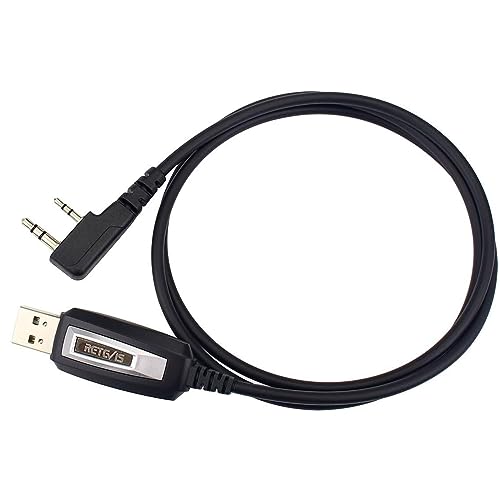Amateur radio is as popular as ever and there are a number of radio hardware manufacturers with products on the market today. The most popular and cost-effective option is Baofeng. However there are a number of other manufacturers that are worthwhile competitors.
In this post, we compare Baofeng with Retevis.
The UV-5R is one of the most recognizable products from Baofeng. This model was the first worldwide successful distributed dual band radio (VHF/UHF) of a Chinese brand [1]. We decided to use this very popular product and compare it with the Retevis equivalent – namely the RT-5R
Contents
Key differences between Baofeng and Retevis
The table below summarizes key hardware specifications. The significant differences are indicated with ⭐
| Specification | Baofeng UV-5R | Retevis RT-5R |
| Frequency Range VHF/UHF | 144-148 MHz 400-480 MHz | 136-174 MHz 400-520 MHz ⭐ |
| Transmit Output Power | 8 watts ⭐ | 5 watts |
| Channels | 128 | 128 |
| Battery | 1800 mAh ⭐ | 1400mAh |
| Voltage | 4 volts | 7.4 volts |
| PTT | Single and Dual | Single and Dual |
| License | Not required to receive Amateur Individual License FCC (Part 15b, Part 97) | Not required to receive Amateur Individual License FCC (Part 15b, Part 97) |
| Weight | 340.2 grams / 12 ounces | 186 grams / 6.6 ounces ⭐ |
- The difference in transmit power means that the Baofeng will cover some distance (a mile or so) more than the Retevis. The range of the RT-5R is
- 2-3 miles in the city when operating in the UHF band (UHF is best for congested areas)
- 5-10 miles in forested/low hilly areas and
- 25-30 miles on top of mountainous regions
- The RT-5R allows operation in the MURS band (151-154 MHz) which is a plus. In general it has a larger frequency range of operation.
- The Baofeng UV-5R comes pre-locked to meet FCC regulations while the Retevis RT-5R must be manually configured to block frequencies where transmission is either not allowed or only permitted if the user has a license
- The UV-5R has a larger battery than the RT-5R so longer intervals between recharge relative to the RT-5R
- The RT-5R is lighter than the UV-5R and therefore more portable.
Product similarities
- Both the Baofeng UV-5R and the Retevis RT-5R have a straightforward menu through the LCD, with which a user can program them. They both can also be configured with the aid of a computer
- Both are dual-band ham radios supporting the VHF and UHF radio frequencies
- Their monitor function allows you to access the voice enhancement capability in the case of weak signals
- Both have a flashlight that helps provide primary light and also work as an SOS tool when set to blink continuously
- Their keypads can both be locked to prevent accidentally switching channels as you operate them
- Their VOX functionality allows for hands-free use as you drive or go about other errands
- Both have the Squelch function, which helps reduce unnecessary channel noise when there’s no transmission
What users say
We did some research online to understand user feedback on both radios. Let’s take a look at what people think about each
Baofeng UV-5R
Most users agree that the Baofeng UV-5R is a powerful and worthwhile purchase if you are seeking to meet your ham radio needs. Despite coming at a pocket-friendly price, it continuously and consistently receives broadcasts from over 20 miles away.
The provision to accessorize it due to its removable antenna and battery ensure that a user receives much better signal reception and battery life. Its advanced features and beginner friendliness make it an excellent choice for both experts and beginners who have just passed their tech license exam.
Multiple users complained about the Baofeng UV-5R’s inability to transmit on the GMRS, FRS, and MURS frequencies (FCC locked), only transmitting on channel mode. The same users, though, admit that they did receive signals on those frequencies – for one-way usage as a radio scanner.
Retevis RT-5R
Many users commended the Retevis RT-5R for transmitting through the MURS frequency despite being cheaper than most other radios that support the same frequency. Users need the programming software and cable accessory to block out unlicensed channels (if required).
Users commented that they would like to see more clear-cut instructions for programming and operating it.
Which device you should choose?
Before zeroing down on either the Baofeng UV-5R or the Retevis RT-5R, you should consider; what your ham radio needs are, whether or not you hold a license and how much time and effort you want to spend configuring your radio.
The Baofeng UV-5R comes transmit-locked to meet the FCC regulation for GMRS, and other frequencies that need licensing to access. It is, therefore more suitable for users who don’t want the hassle of having to configure the radio to block out channels and frequencies they are not allowed to use.
If you want standard functionality, then we recommend purchasing the Baofeng UV-5R since it will still leave you in a position to configure it using CHIRP software should you need to. All this while still staying within regulatory limits if you have no license.
If you want to use the GMRS, FRS, MURS frequencies out of the box on the other hand, we recommend the Retevis RT-5R.
Wikipedia References
[1] Baofeng UV-5R
[2] GMRS
[3] MURS
[4] FRS
Related Posts
- Baofeng vs Yaesu – which one is better?
- Baofeng Range Calculator
- Can Baofeng talk to CB Radio?
- CB Radio vs Ham Radio – which one is better?



